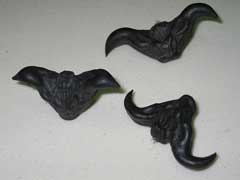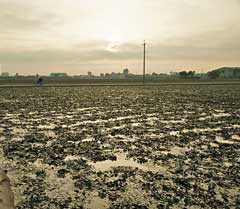 |
|
|
 |
| commons.wikimedia.org/wiki/User:Fred_Hsu |
Translate this page:
Summary
Physical Characteristics
![]()
![]() Trapa bicornis is a PERENNIAL.
Trapa bicornis is a PERENNIAL.
See above for USDA hardiness. It is hardy to UK zone 5 and is not frost tender. The species is hermaphrodite (has both male and female organs).
Suitable for: light (sandy), medium (loamy) and heavy (clay) soils. Suitable pH: mildly acid and neutral soils. It cannot grow in the shade. It can grow in water.
UK Hardiness Map
US Hardiness Map
Synonyms
T. bicornuta.
Plant Habitats
Pond;
Edible Uses
Edible Parts: Seed
Edible Uses:
Seed - cooked. A crunchy texture with a bland flavour[206]. Rich in starch, the raw seed contains a deleterious principle that is destroyed by cooking[200]. The cooked seed can be dried and ground into a powder[200].
References More on Edible Uses
Medicinal Uses
Plants For A Future can not take any responsibility for any adverse effects from the use of plants. Always seek advice from a professional before using a plant medicinally.
Antipyretic Astringent Cancer Tonic
The flowers are astringent in fluxes[218]. The fruit is used in the treatment of fever and sunstroke[218]. The plant is anticancer, antipyretic and tonic[218].
References More on Medicinal Uses
The Bookshop: Edible Plant Books
Our Latest books on Perennial Plants For Food Forests and Permaculture Gardens in paperback or digital formats.

Edible Tropical Plants
Food Forest Plants for Hotter Conditions: 250+ Plants For Tropical Food Forests & Permaculture Gardens.
More

Edible Temperate Plants
Plants for Your Food Forest: 500 Plants for Temperate Food Forests & Permaculture Gardens.
More

More Books
PFAF have eight books available in paperback and digital formats. Browse the shop for more information.
Shop Now
Other Uses
References More on Other Uses
Cultivation details
An aquatic plant, floating by means of inflated petioles, it succeeds in still or slowly-flowing water requiring a position in full sun and a slightly acidic water with a rich planting medium[200]. Plants require a high summer temperature in order to perform well, they are not frost hardy[206]. Some botanists regard this species as no more than a part of the one highly polymorphic species T. natans[200]. This species was used for food in Neolithic Britain[200].
References Carbon Farming Information and Carbon Sequestration Information
Temperature Converter
Type a value in the Celsius field to convert the value to Fahrenheit:
Fahrenheit:
The PFAF Bookshop
Plants For A Future have a number of books available in paperback and digital form. Book titles include Edible Plants, Edible Perennials, Edible Trees,Edible Shrubs, Woodland Gardening, and Temperate Food Forest Plants. Our new book is Food Forest Plants For Hotter Conditions (Tropical and Sub-Tropical).
Shop Now
Plant Propagation
Seed - harvest in late summer and store overwinter in a jar of water in a cold but frost-free place. The seed quickly loses its vitality if it is allowed to become dry. Sow in spring, placing one seed in each pot and submerging them under a few centimetres of water.
Other Names
If available other names are mentioned here
Native Range
TEMPERATE ASIA: Turkey (northwest), Georgia, China (Anhui Sheng, Fujian Sheng, Guangdong Sheng, Guangxi Zhuangzu Zizhiqu, Guizhou Sheng, Hainan Sheng, Hebei Sheng, Heilongjiang Sheng, Henan Sheng, Hubei Sheng, Hunan Sheng, Jiangsu Sheng, Jiangxi Sheng, Jilin Sheng, Liaoning Sheng, Nei Mongol Zizhiqu, Shaanxi Sheng, Shandong Sheng, Sichuan Sheng, Xinjiang Uygur Zizhiqu, Xizang Zizhiqu, Yunnan Sheng, Zhejiang Sheng), Japan TROPICAL ASIA: India, Pakistan, Laos, Thailand, Vietnam, Indonesia, Malaysia, Philippines EUROPE: Austria, Switzerland, Czech Republic, Germany, Hungary, Poland, Slovakia, Belarus, Ukraine (incl. Krym), Albania, Bulgaria, Greece, Croatia, Italy, Romania, Serbia, Slovenia, Spain (incl. Baleares), France AFRICA: Algeria, Tunisia, Sudan, Tanzania, Uganda, Guinea-Bissau, Angola, Mozambique, Malawi, Zambia, Zimbabwe, Botswana, Namibia, South Africa (KwaZulu-Natal)
Weed Potential
Right plant wrong place. We are currently updating this section.
Please note that a plant may be invasive in one area but may not in your area so it's worth checking.
Conservation Status
IUCN Red List of Threatened Plants Status :

Growth: S = slow M = medium F = fast. Soil: L = light (sandy) M = medium H = heavy (clay). pH: A = acid N = neutral B = basic (alkaline). Shade: F = full shade S = semi-shade N = no shade. Moisture: D = dry M = Moist We = wet Wa = water.
Now available:
Food Forest Plants for Mediterranean Conditions
350+ Perennial Plants For Mediterranean and Drier Food Forests and Permaculture Gardens.
[Paperback and eBook]
This is the third in Plants For A Future's series of plant guides for food forests tailored to
specific climate zones. Following volumes on temperate and tropical ecosystems, this book focuses
on species suited to Mediterranean conditions—regions with hot, dry summers and cool, wet winters,
often facing the added challenge of climate change.
Read More
Expert comment
Author
Osbeck.
Botanical References
200
Links / References
For a list of references used on this page please go here
Readers comment
© 2010, Plants For A Future. Plants For A Future is a charitable company limited by guarantee, registered in England and Wales. Charity No. 1057719, Company No. 3204567.